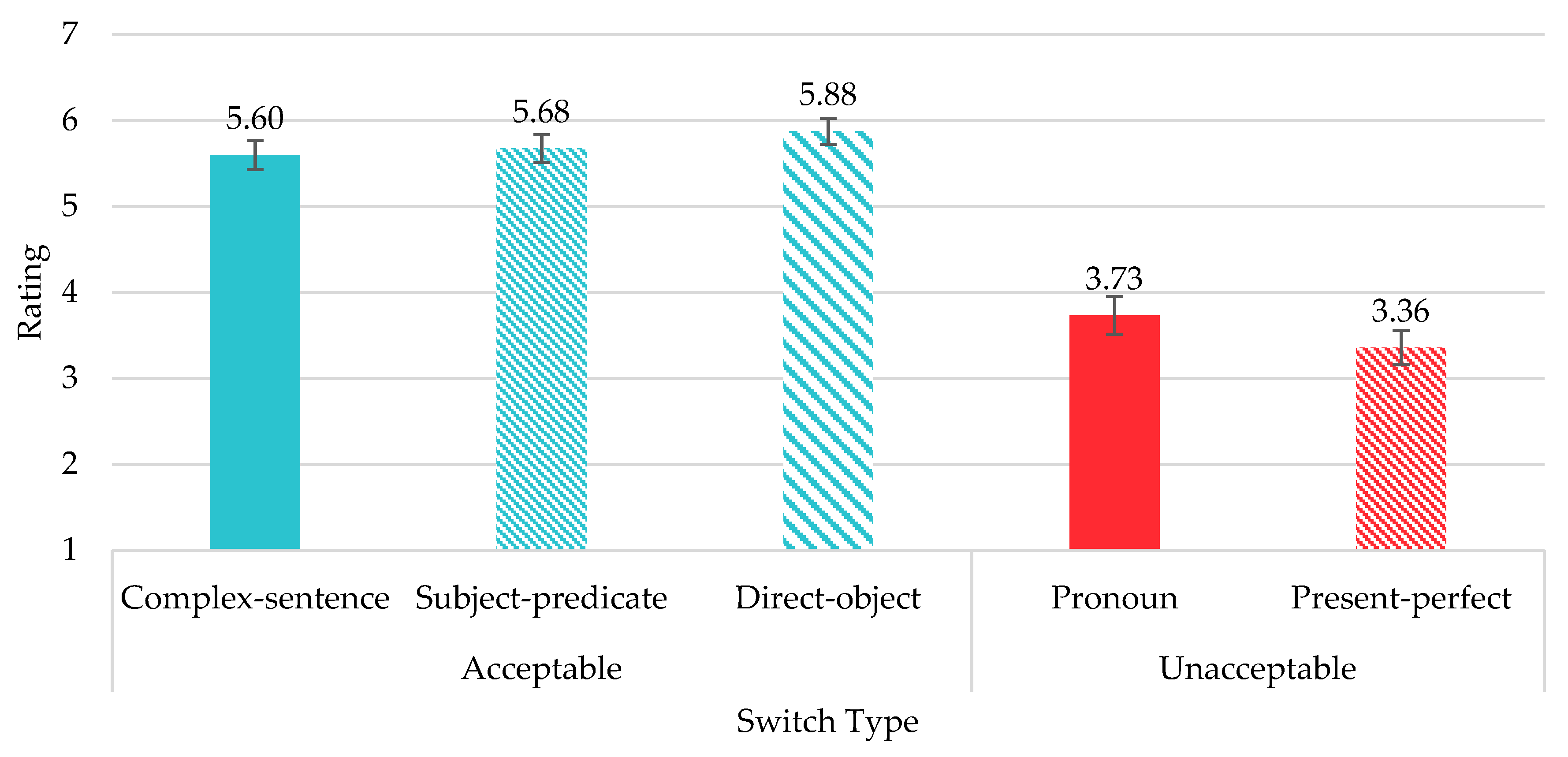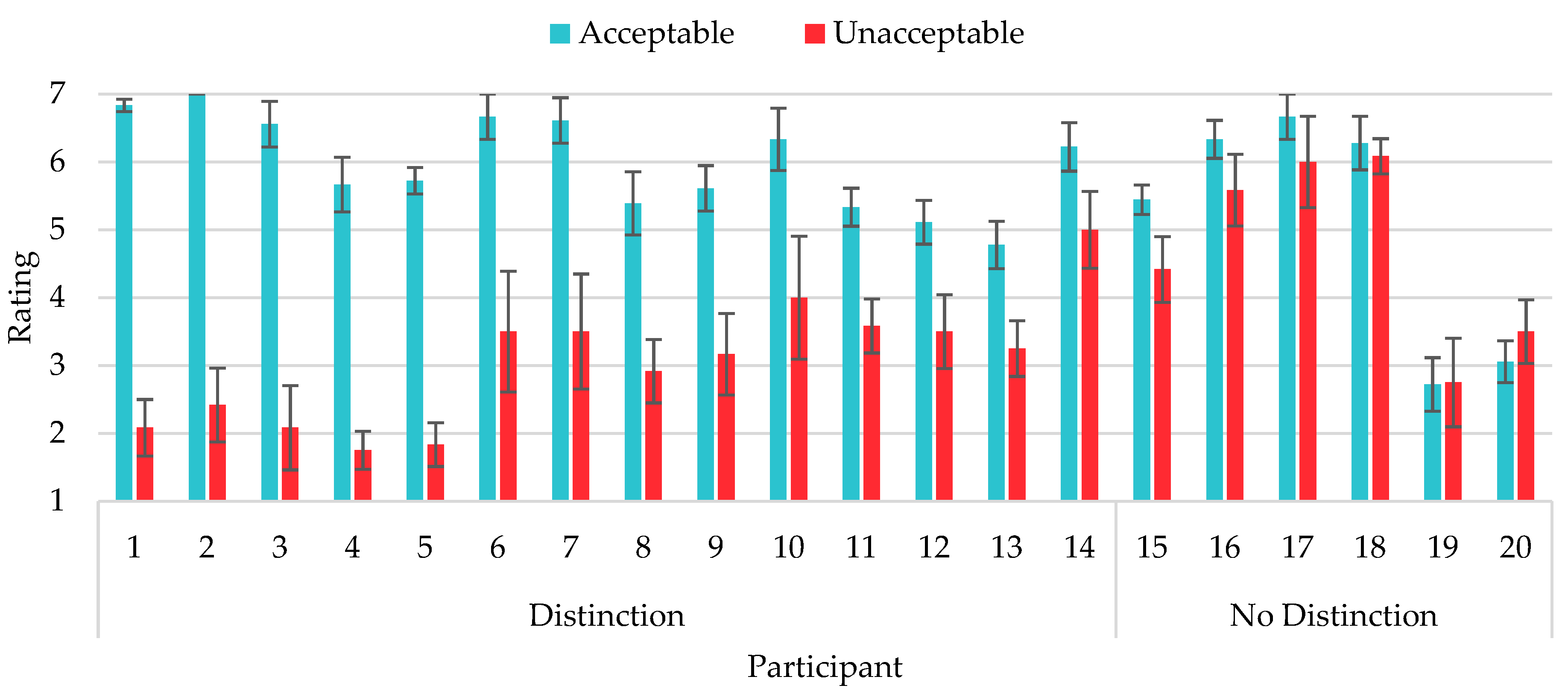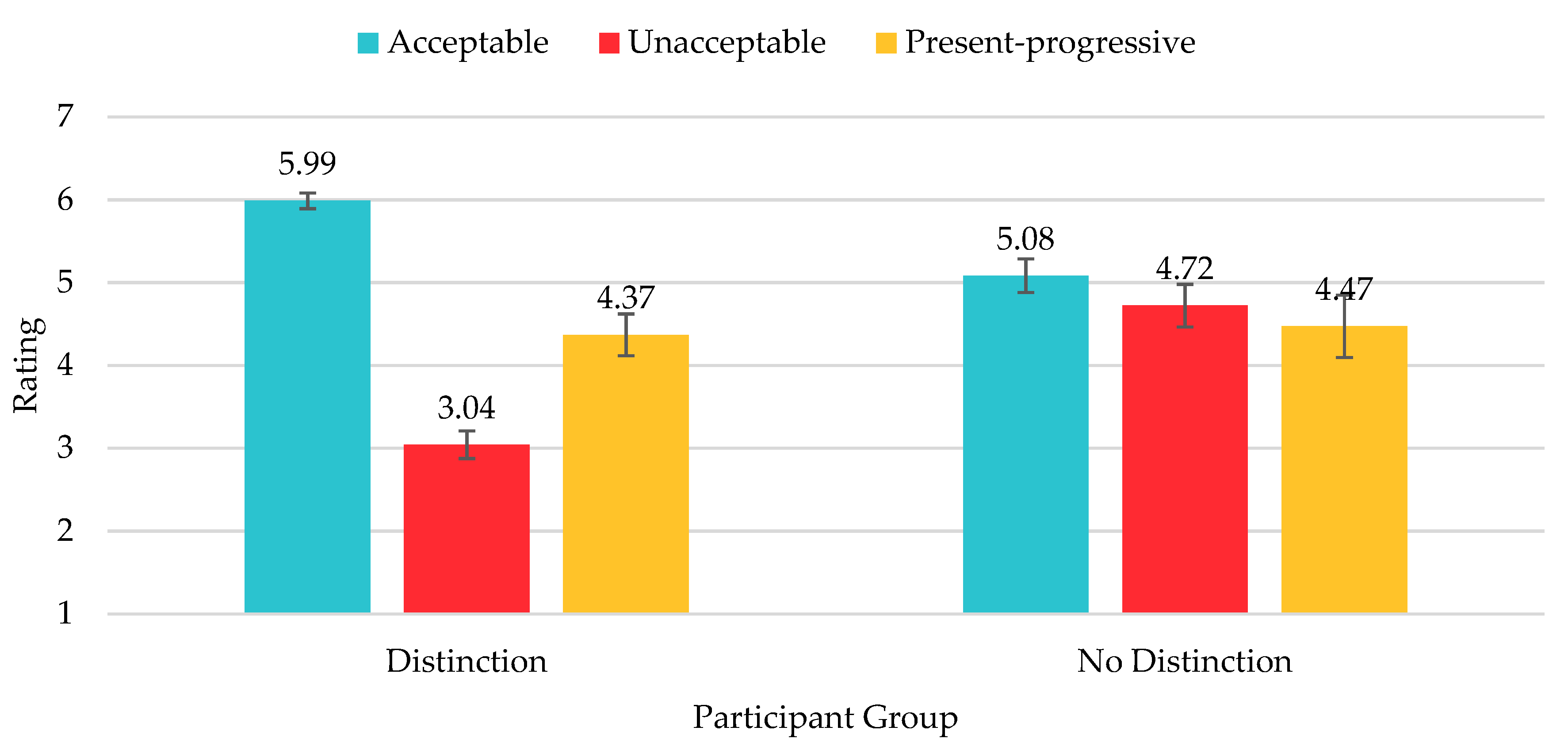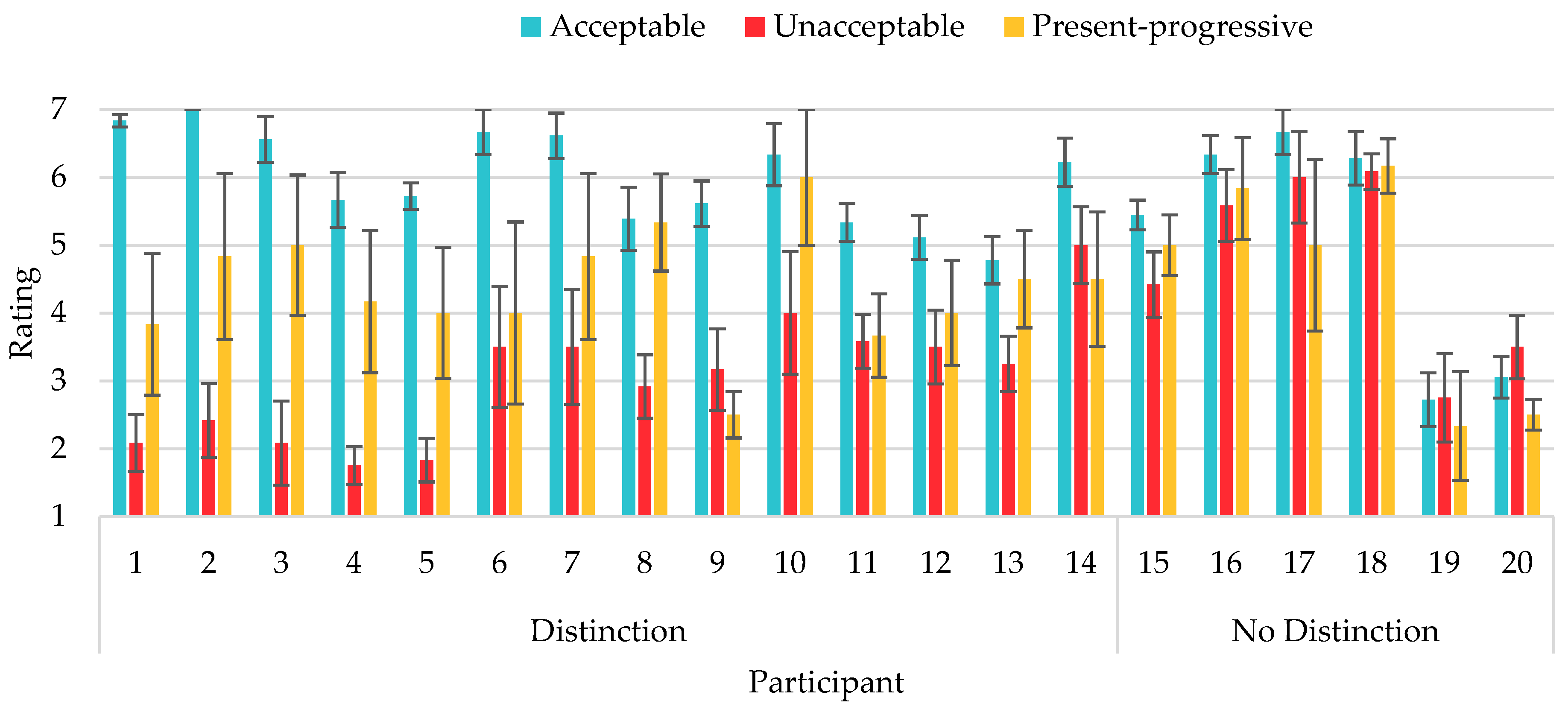Control Stimuli in Experimental Code-Switching Research
Abstract
:1. Introduction
2. Background
2.1. Code-Switching as a Data Source and a Linguistic Tool
2.2. Methods in Code-Switching Research
2.3. Defining (Un)grammatical Code-Switches
In other words, although the results of an AJT may produce different ratings for any number of various types of sentences, as far as syntactic theory is concerned sentences are either well-formed or not. The variation within the results can be derived from any number of extra-grammatical factors, such as plausibility, working memory limitations, etc. It is within the analysis of experimental syntax research that one must use interpretation to determine what such gradated results mean. Nonetheless, the methods employed in such research should aim to help reduce the amount of interpretation needed. Furthermore, within a generativist approach to CS (Grimstad et al. 2018; MacSwan 1999, 2014), if categorical grammaticality applies to monolingual utterances, then it must also do so for mixed utterances. Although experimental CS research may produce a spectrum of acceptability, we should follow the same argument that Sprouse (2007) makes for syntactic research in general.While many sentences are either clearly acceptable or clearly unacceptable, a significant number of sentences fall somewhere in between in a gray area of partial acceptability. This fact has been explicitly admitted by linguists since at least Chomsky 1965. The working assumption adopted by most linguists over the past 40 years has been that these intermediate levels of acceptability are caused by properties other than grammatical knowledge.
| 1. | a. | * | His friends have | estudiado | español. |
| studied | Spanish | ||||
| ‘His friends have studied Spanish.’ | |||||
| b. | His friends | han | estudiado | español. | |
| have | studied | Spanish | |||
| ‘His friends have studied Spanish.’ | |||||
| c. | His friends have studied | español. | |
| Spanish | |||
| ‘His friends have studied Spanish.’ | |||
2.4. Research Questions and Hypotheses
- Is there variation between different types of CS control stimuli?
- How can control stimuli be used to account for CS heterogeneity?
- How can control stimuli be used as a baseline comparison of CS (un)acceptability?
3. Materials and Methods
3.1. Participants
3.2. Task
3.3. Stimuli
| 2. | a. | We’ll hear a sound | si | alguien | toca | el | timbre. |
| if | someone | rings | the | doorbell | |||
| ‘We’ll hear a sound if someone rings the doorbell.’ | |||||||
| b. | My brother | está | pescando. | |
| is | fishing | |||
| ‘My brother is fishing.’ | ||||
| c. | He has | una | mala | reputación. | |
| a | bad | reputation | |||
| ‘He has a bad reputation.’ | |||||
| 3. | a. | * | They | compraron | unas | manzanas. |
| bought | some | apples | ||||
| ‘They bought some apples.’ | ||||||
| b. | * | The students have | prestado | atención | a | la | profesora | hoy. | |
| paid | attention | to | the | professor | today | ||||
| ‘The students have paid attention to the professor today.’ | |||||||||
| 4. | Her colleagues are | viendo | muchas | películas | este | mes. | |
| seeing | many | movies | this | month | |||
| ‘Her colleagues are seeing many movies this month.’ | |||||||
4. Results
4.1. General Results
4.2. Heterogeneity Results
4.3. Comparison Results
5. Discussion
| 5. | Her colleagues | están | viendo | muchas | películas | este | mes. |
| are | seeing | many | movies | this | month | ||
| ‘Her colleagues are seeing many movies this month.’ | |||||||
Funding
Conflicts of Interest
Appendix A
- (1)
- There is likely that John likes Mary.We will ask you to rate sentences from ‘completely unacceptable’ to ‘completely acceptable’. The sentence you just saw would be ‘completely unacceptable’ because native speakers of English find this sentence very strange. It is perfectly understandable but there is something about its structure that sounds un-English.En cambio, the following sentence sounds completely fine:
- (2)
- There is someone in the garden.Ahora veamos un ejemplo en español:
- (3)
- Esa película le ha gustado a nadie.De nuevo, esta oración no es aceptable. Aunque la entendemos perfectamente, hay algo que suena raro en esta oración, no es una oración en español.Al contrario, esta oración es normalísima.
- (4)
- Juan compró el periódico.Y ahora comparemos two examples in code-switching:
- (5)
- John le bought una casa.Muchos hablantes bilingües de español/inglés who practice code-switching regularly or occasionally agree that sentence (5) sounds strange.Sentence (6), on the other hand, sounds completely fine para los hablantes bilingües.
- (6)
- Mis primos nadaron in the pool for three hours.In the survey, you might find that some sentences are neither perfect nor totally awful. Although we expect that you will evaluate most of the sentences you will read as ‘completely unacceptable’ or ‘completely acceptable’, te damos varias opciones por si hay dudas. We also provide you with an ‘unsure’ option, in case you really, really are not sure.Lee la siguiente oración.
- (7)
- I know my neighbor chewed gum yesterday.This sentence may sound odd because it doesn’t seem like something anyone would ever say or care about. The question is whether this is una oración posible en inglés. Si es el caso, es completamente aceptable.Now, take a moment to rate the following sentence:
- (8)
- He surprise that no one called yesterday.This sentence is comprehensible and the situation seems plausible (una posible situación: ayer él esperaba una llamada, pero al final no lo llamaron), but the sentence is not possible to say in English. It’s just not English, for whatever reason, and therefore it is completely unacceptable.Para juzgar cada oración, the question, then, is whether the sentence is possible in English, Spanish or code-switching, even if you don’t know why anyone would actually say the sentence.And let’s take a look at one final pair of sentences. First:
- (9)
- Compró Juan un nuevo libro for the party this week?En cuanto al significado, this sentence is a little odd. You don’t usually buy a book for a party. Pero como no hay nada raro en la forma de la oración, it would be completely acceptable.Second:
- (10)
- I want ir al mercado.Esta oración, on the other hand, se puede entender pero no se puede decir. Because of that, it would be completely unacceptable.
Appendix B
Todos van a mojarse if it rains today.‘Everyone will get wet if it rains today.’Ella se esconde when he calls her.‘She hides when he calls her.’Voy a salir if I feel sick.‘I am going to leave if I feel sick.’Sometimes he’ll go to the store y olvida lo que estaba buscando.‘Sometimes he’ll go to the store and forget what he was looking for.’We’ll hear a sound si alguien toca el timbre.‘We’ll hear a sound if someone rings the doorbell.’We’ll tell him si lo vemos.‘We’ll tell him if we see him.’
Casi nadie visits the museum.‘Almost no one visits the museum.’Ninguna persona aquí has a knife.‘No person here has a knife.’El mapa costs six dollars.‘The map costs six dollars.’Her entire family habla español.‘Her entire family speaks Spanish.’My brother está pescando.‘My brother is fishing.’The bear ya no ha muerto.The bear hasn’t died yet.
Sólo tengo five dollars.‘I only have five dollars.’No les han dado an opportunity to leave.‘They haven’t given them an opportunity to leave.’Van a hacer a lot of different activities.‘They are going to do a lot of different activities.’He has una mala reputación.‘He has a bad reputation.’The earthquake destroyed la ciudad y los suburbios.‘The earthquake destroyed the city and the suburbs.The man ate un sándwich de atún.‘The man ate a tuna sandwich.’
Él met our grandmother.‘He met our grandmother.’He pidió una cerveza.‘He ordered a beer.’Ellos bought some peaches.‘They bought some peaches.’They compraron unas manzanas.‘They bought some apples.’Ellas started to sing.‘They started to sing.’She conoció a nuestro primo.‘She met our cousin.’
Su hermano ha trained at the gym every day.‘His brother has trained at the gym every day.’The students have prestado atención a la profesora hoy.‘The students have paid attention to the professor today.’Nuestra tía ha taught fourth grade at the elementary school.‘Our aunt has taught fourth grade at the elementary school.’Her colleagues have visto muchas películas this year.‘Her colleagues have seen many movies this year.’Sus amigas han gone shopping with their mothers recently.‘Their friends have gone shopping with their mothers recently.’Your neighbors have comido en ese restaurante varias veces.‘Your neighbors have eaten in that restaurant several times.’
Su hermano está training at the gym right now.‘His brother is training at the gym right now.’The students are prestando atención a la profesora mucho.‘The students are paying attention to the professor a lot.’Nuestra tía está teaching biology at the high school.‘Our aunt is teaching biology at the high school.’Her colleagues are viendo muchas películas este mes.‘Her colleagues are watching many movies this month.’Sus amigas están going shopping with their mothers this weekend.‘Their friends are going shopping with their mothers this weekend.’Your neighbors are comiendo en ese restaurante ahora mismo.Your neighbors are eating in that restaurant right now.’
Susana y él met our uncle.‘Susan and him met our uncle.’Ese chico met our cousin.‘That boy met our cousin.’Lisa and him pidieron dos copas de vino.‘Lisa and him ordered two glasses of wine.’That guy pidió un vaso de agua.‘That guy ordered a glass of water.’Tú y ellos bought some oranges.‘You and them bought some oranges.’Esos hombres bought some apples.Those guys bought some apples.’You and them compraron unas naranjas.‘You and them bought some oranges.’Those guys compraron unos duraznos.Those guys bought some peaches.’Esos chicos y ellas started to laugh.‘Those boys and them started to laugh.’Esas chicas started to dance.‘Those girls started to dance.’Michael and her conocieron a nuestra tía.‘Michael and her met our aunt.’That girl conoció a nuestra abuela.‘That girl met our grandmother.’Su hermano trains at the gym regularly.‘His brother trains at the gym regularly.’The students prestan atención a la profesora en clase.‘The students pay attention to the professor in class.’Nuestra tía teaches psychology at the community college.‘Our aunt teaches psychology at the community college.’Her colleagues ven muchas películas en el cine.‘Her colleagues see many movies in the theater.’Sus amigas go shopping with their mothers frequently.‘Their friends go shopping with their mothers frequently.’Your neighbors comen en ese restaurante todas las semanas.‘Your neighbors eat at that restaurant every week.’
References
- Badiola, Lucía, and Ariane Sande. 2018. Gender assignment in Basque/Spanish mixed Determiner Phrases: A study of simultaneous bilinguals. In Code-switching—Experimental Answers to Theoretical Questions: In Honor of Kay González-Vilbazo. Edited by Luis López. Philadelphia: John Benjamins, pp. 15–38. [Google Scholar] [CrossRef]
- Badiola, Lucía, Rodrigo Delgado, Ariane Sande, and Sara Stefanich. 2018. Code-switching attitudes and their effects on acceptability judgment tasks. Linguistic Approaches to Bilingualism 8: 5–24. [Google Scholar] [CrossRef]
- Balam, Osmer. 2016. Mixed verbs in contact Spanish: Patterns of use among emergent and dynamic bi/multilinguals. Languages 1: 3. [Google Scholar] [CrossRef]
- Bartlett, Laura, and Kay González-Vilbazo. 2010. Classifiers in Spanish-Taiwanese code-switching. In Proceedings from the Annual Meeting of the Chicago Linguistic Society. Chicago: Chicago Linguistic Society, pp. 1–15. [Google Scholar]
- Belazi, Hedi M., Edward J. Rubin, and Almeida Jacqueline Toribio. 1994. Code switching and X-bar theory: The functional head constraint. Linguistic Inquiry 25: 221–37. [Google Scholar] [CrossRef]
- Bentahila, Abdelâli, and Eirlys E. Davies. 1983. The syntax of Arabic-French code-switching. Lingua 59: 301–30. [Google Scholar] [CrossRef]
- Cantone, Katja Francesca, and Jeff MacSwan. 2009. Adjectives and word order: A focus on Italian-German codeswitching. In Multidisciplinary Approaches to Code Switching. Edited by Ludmila Isurin, Donald Winford and Kees de Bot. Amsterdam: John Benjamins, pp. 243–77. [Google Scholar]
- Cardinaletti, Anna, and Michal Starke. 1999. The typology of structural deficiency: A case study of the three classes of pronouns. In Clitics in the languages of Europe. Edited by Henk C. van Riemsdijk. Berlin: De Gruyter, pp. 145–233. [Google Scholar]
- Chomsky, Noam. 1986. Knowledge of Language: Its Nature, Origin, and Use. Westport: Greenwood Publishing Group. [Google Scholar]
- De Houwer, Annick. 1998. By way of introduction: Methods in studies of bilingual first language acquisition. International Journal of Bilingualism 2: 249–63. [Google Scholar] [CrossRef]
- Delgado, Rodrigo. 2018. The familiar and the strange: Gender assignment in Spanish/English mixed DPs. In Code-Switching—Experimental Answers to Theoretical Questions: In honor of Kay González-Vilbazo. Edited by Luis López. Philadelphia: John Benjamins, pp. 39–62. [Google Scholar] [CrossRef]
- de Nicolás, Irati, and Jon Robledo. 2018. Adjective placement in Spanish and Basque mixed DPs. In Code-Switching—Experimental Answers to Theoretical Questions: In Honor of Kay González-Vilbazo. Edited by Luis López. Philadelphia: John Benjamins, pp. 63–100. [Google Scholar] [CrossRef]
- Ebert, Shane. 2014. The Morphosyntax of Wh-questions: Evidence from Spanish-English Code-Switching. Ph.D. dissertation, University of Illinois at Chicago, Chicago, IL, USA, May 7. [Google Scholar]
- Ebert, Shane, and Bradley Hoot. 2018. That-trace effects in Spanish-English code-switching. In Code-Switching—Experimental Answers to Theoretical Questions: In Honor of Kay González-Vilbazo. Edited by Luis López. Philadelphia: John Benjamins, pp. 101–45. [Google Scholar] [CrossRef]
- Ebert, Shane, and Bryan Koronkiewicz. 2018. Monolingual stimuli as a foundation for analyzing code-switching data. Linguistic Approaches to Bilingualism 8: 25–66. [Google Scholar] [CrossRef]
- Finer, Daniel L. 2014. Movement triggers and reflexivization in Korean-English codeswitching. In Grammatical Theory and Bilingual Codeswitching. Edited by Jeff MacSwan. Cambridge: MIT Press, pp. 37–62. [Google Scholar] [CrossRef]
- Giancaspro, David. 2015. Code-switching at the auxiliary-VP boundary. Linguistic Approaches to Bilingualism 5: 379–407. [Google Scholar] [CrossRef]
- González-Vilbazo, Kay, and Bryan Koronkiewicz. 2016. Tú y yo can codeswitch, nosotros cannot: Pronouns in Spanish-English codeswitching. In Spanish-English Codeswitching in the Caribbean and the US. Edited by Rosa E. Guzzardo Tamargo, Catherine M. Mazak and M. Carmen Parafita Couto. Philadelphia: John Benjamins, pp. 237–60. [Google Scholar] [CrossRef]
- González-Vilbazo, Kay, and Luis López. 2011. Some properties of light verbs in code-switching. Lingua 121: 832–50. [Google Scholar] [CrossRef]
- González-Vilbazo, Kay, and Luis López. 2012. Little v and parametric variation. Natural Language & Linguistic Theory 30: 33–77. [Google Scholar] [CrossRef]
- González-Vilbazo, Kay, and Sergio E. Ramos. 2018. Codeswitching. In The Oxford Handbook of Ellipsis. Edited by Jeroen van Craenenbroeck and Tanja Temmerman. Oxford: Oxford University Press, pp. 458–78. [Google Scholar] [CrossRef]
- González-Vilbazo, Kay, Laura Bartlett, Sarah Downey, Shane Ebert, Jeanne Heil, Bradley Hoot, Bryan Koronkiewicz, and Sergio E. Ramos. 2013. Methodological considerations in code-switching research. Studies in Hispanic and Lusophone Linguistics 6: 119–38. [Google Scholar] [CrossRef]
- Grimstad, Maren Berg, Brita Ramsevik Riksem, Terje Lohndal, and Tor A. Åfarli. 2018. Lexicalist vs. exoskeletal approaches to language mixing. The Linguistic Review 35: 187–218. [Google Scholar] [CrossRef]
- Grosjean, François. 1998. Studying bilinguals: Methodological and conceptual issues. Bilingualism: Language and Cognition 1: 131–49. [Google Scholar] [CrossRef]
- Gullberg, Marianne, Peter Indefrey, and Pieter Muysken. 2009. Research techniques for the study of code-switching. In The Cambridge Handbook of Linguistic Code-Switching. Edited by Barbara E. Bullock and Almeida Jacqueline Toribio. Cambridge: Cambridge University Press, pp. 21–39. [Google Scholar]
- Guzzardo Tamargo, Rosa E., and Paola E. Dussias. 2013. Processing of Spanish-English code-switches by late bilinguals. In BUCLD 37: Proceedings of the 37th Annual Boston University Conference on Language Development. Edited by Sarah Baiz, Nora Goldman and Rachel Hawkes. Boston: Cascadilla Press, pp. 134–46. [Google Scholar]
- Jansen, Veronika, Jasmin Müller, and Natascha Müller. 2012. Code-switching between an OV and a VO language: Evidence from German-Italian, German-French and German-Spanish children. Linguistic Approaches to Bilingualism 2: 337–78. [Google Scholar] [CrossRef]
- Koronkiewicz, Bryan. 2014. Pronoun Categorization: Evidence from Spanish/English Code-Switching. Ph.D. dissertation, University of Illinois at Chicago, Chicago, IL, USA, April 21. [Google Scholar]
- Koronkiewicz, Bryan, and Shane Ebert. 2018. Modality in experimental code-switching research. In Code-switching—Experimental Answers to Theoretical Questions: In Honor of Kay González-Vilbazo. Edited by Luis López. Amsterdam: John Benjamins Publishing, pp. 147–76. [Google Scholar] [CrossRef]
- Liceras, Juana M., Raquel Fernández Fuertes, Susana Perales, Rocío Pérez-Tattam, and Kenton Todd Spradlin. 2008. Gender and gender agreement in bilingual native and non-native grammars: A view from child and adult functional-lexical mixings. Lingua 118: 827–51. [Google Scholar] [CrossRef]
- MacSwan, Jeff. 1999. A Minimalist Approach to Intrasentential Code Switching. New York: Garland. [Google Scholar]
- MacSwan, Jeff, ed. 2014. Programs and proposals in codeswitching research: Unconstraining theories of bilingual language mixing. In Grammatical Theory and Bilingual Codeswitching. Cambridge: MIT Press, pp. 1–33. [Google Scholar]
- MacSwan, Jeff, and Kara T. McAlister. 2010. Naturalistic and elicited data in grammatical studies of codeswitching. Studies in Hispanic and Lusophone Linguistics 3: 521–32. [Google Scholar] [CrossRef]
- Montrul, Silvina, and Roumyana Slabakova. 2003. Competence similarities between native and near-native speakers: An investigation of the preterite/imperfect contrast in Spanish. Studies in Second Language Acquisition 25: 351–98. [Google Scholar] [CrossRef]
- O’Neill, Robert, Edwin T. Cornelius, and Gay N. Washburn. 1981. American Kernal Lessons: Advanced Student’s Book. London: Longman. [Google Scholar]
- Poplack, Shana. 1980. Sometimes I’ll start a sentence in Spanish y termino en español: Toward a typology of code-switching. Linguistics 18: 581–618. [Google Scholar] [CrossRef]
- Sande, Ariane. 2018. C Plus T as a Necessary Condition for pro-drop: Evidence from Code-Switching. Ph.D. dissertation, University of Illinois at Chicago, Chicago, IL, USA, November 7. [Google Scholar]
- Sprouse, Jon. 2007. Continuous acceptability, categorical grammaticality, and experimental syntax. Biolinguistics 1: 123–34. [Google Scholar]
- Sprouse, Jon. 2008. Magnitude estimation and the non-linearity of acceptability judgments. In Proceedings of the 27th West Coast Conference on Formal Linguistics. Edited by Natasha Abner and Jason Bishop. Somerville: Cascadilla Proceedings Project, pp. 397–403. [Google Scholar]
- Sprouse, Jon, and Diogo Almeida. 2012. Assessing the reliability of textbook data in syntax: Adger’s Core Syntax. Journal of Linguistics 48: 609–52. [Google Scholar] [CrossRef]
- Sprouse, Jon, Carson T. Schütze, and Diogo Almeida. 2013. A comparison of informal and formal acceptability judgments using a random sample from Linguistic Inquiry 2001–2010. Lingua 134: 219–48. [Google Scholar] [CrossRef]
- Stadthagen-González, Hans, Luis López, and M. Carmen Parafita Couto. 2018. Using two-alternative forced choice tasks and Thurstones’s law of comparative judgments for code-switching research. Linguistic Approaches to Bilingualism 8: 67–97. [Google Scholar] [CrossRef]
- Timm, Lenora A. 1975. Spanish-English code-switching: El porque and how-not-to. Romance Philology 28: 473–82. [Google Scholar]
- van Hell, Janet G., Carla B. Fernández, Gerrit Jan Kootstra, Kaitlyn A. Litcofsky, and Caitlin Y. Ting. 2018. Electrophysiological and experimental-behavioral approaches to the study of intra-sentential code-switching. Linguistic Approaches to Bilingualism 8. [Google Scholar] [CrossRef]
- Woolford, Ellen. 1983. Bilingual code-switching and syntactic theory. Linguistic Inquiry 14: 520–36. [Google Scholar]
| 1 | See Koronkiewicz and Ebert (2018) for evidence against such a potential bias presenting itself in an experimental CS context. |
| 2 | See the aforementioned work on methodological concerns for discussion of how specifically such factors can affect research, including De Houwer (1998), González-Vilbazo et al. (2013), Grosjean (1998), Gullberg et al. (2009), and others. |
| 3 | Given that stimuli were presented visually, not aurally, the prosody of the sentences was left uncontrolled. However, following Koronkiewicz and Ebert (2018), there is evidence to suggest that the modality of presentation does not affect the participants’ acceptability judgments, including pronouns. |
| 4 | Examination found no pronoun or present–perfect switches in the Bangor Miami corpus. |
| 5 | It is worth noting that switches with haber as a light verb are prevalent in some bilingual communities, such as in Northern Belize (Balam 2016), but such a switch is a distinct syntactic construction to the one discussed here. |
| 6 | All filler stimuli included subject–predicate switches, with the subject being either a lexical Determiner Phrase or a pair of coordinated pronouns. The fact that they were all the same type of switch was unintentional. |
| 7 | The error bars in all of the figures represent the standard error for each respective mean rating. |
| 8 | See Badiola et al. (2018) for more details about how CS attitudes can affect AJT ratings. |
| 9 | It is possible that the specific language pair(s) being tested may require the exclusion of one or more of these types for syntactic reasons specific to the grammar(s) of one or more languages involved. |




| Factor | English | Spanish | Other i | |||
|---|---|---|---|---|---|---|
| M | SD | M | SD | M | SD | |
| Age of acquisition | 2.3 | 2.5 | 0.9 | 2.1 | - | - |
| Proficiency score | 36.7 (out of 40) ii | 4.9 | 31.8 (out of 50) | 10.6 | - | - |
| Self-rated proficiency: | ||||||
| Overall | 4.9 (out of 5) iii | 0.5 | 3.8 (out of 5) | 0.8 | - | - |
| Listening | 5.0 | 0.0 | 4.4 | 0.9 | - | - |
| Speaking | 5.0 | 0.0 | 3.8 | 1.0 | - | - |
| Reading | 4.8 | 0.7 | 3.9 | 1.2 | - | - |
| Writing | 4.8 | 0.8 | 3.3 | 1.3 | - | - |
| Self-reported exposure | 68.8% | 16.4 | 30.1% | 16.1 | 1.2% | 4.3 |
© 2019 by the author. Licensee MDPI, Basel, Switzerland. This article is an open access article distributed under the terms and conditions of the Creative Commons Attribution (CC BY) license (http://creativecommons.org/licenses/by/4.0/).
Share and Cite
Koronkiewicz, B. Control Stimuli in Experimental Code-Switching Research. Languages 2019, 4, 67. https://doi.org/10.3390/languages4030067
Koronkiewicz B. Control Stimuli in Experimental Code-Switching Research. Languages. 2019; 4(3):67. https://doi.org/10.3390/languages4030067
Chicago/Turabian StyleKoronkiewicz, Bryan. 2019. "Control Stimuli in Experimental Code-Switching Research" Languages 4, no. 3: 67. https://doi.org/10.3390/languages4030067
APA StyleKoronkiewicz, B. (2019). Control Stimuli in Experimental Code-Switching Research. Languages, 4(3), 67. https://doi.org/10.3390/languages4030067





